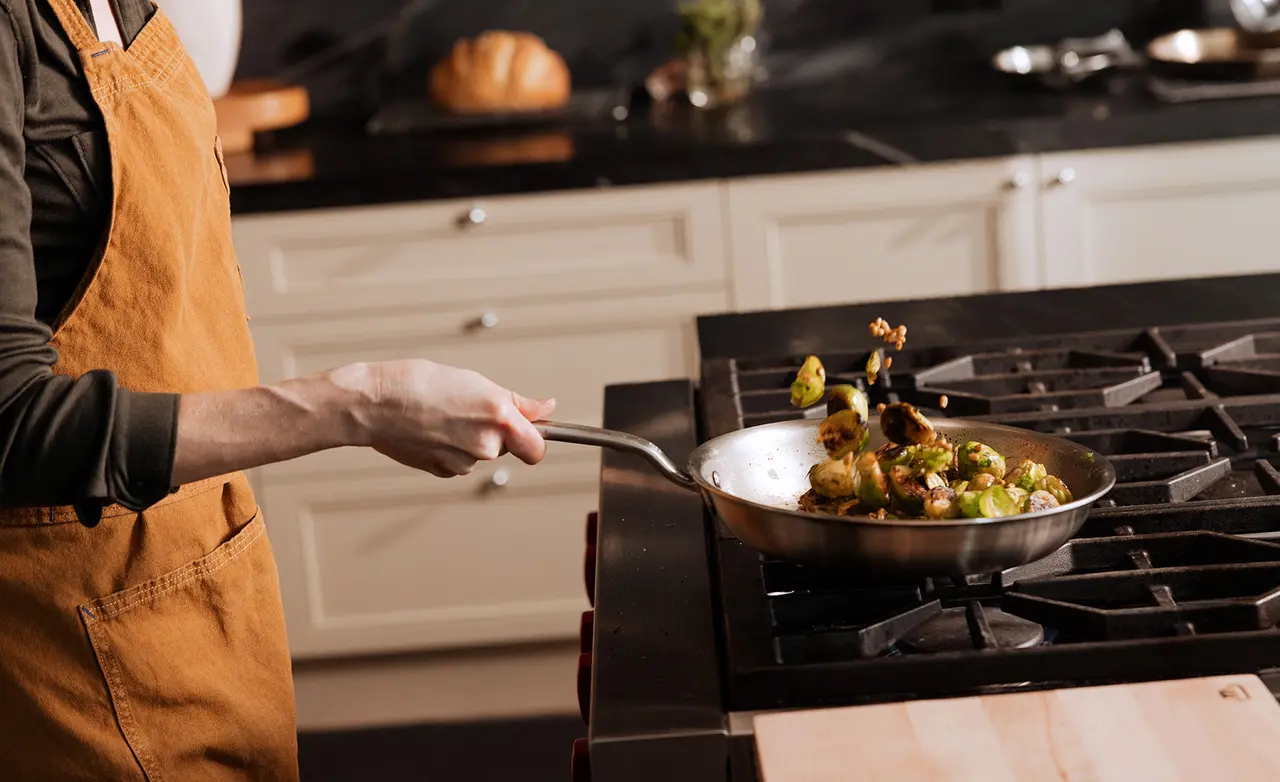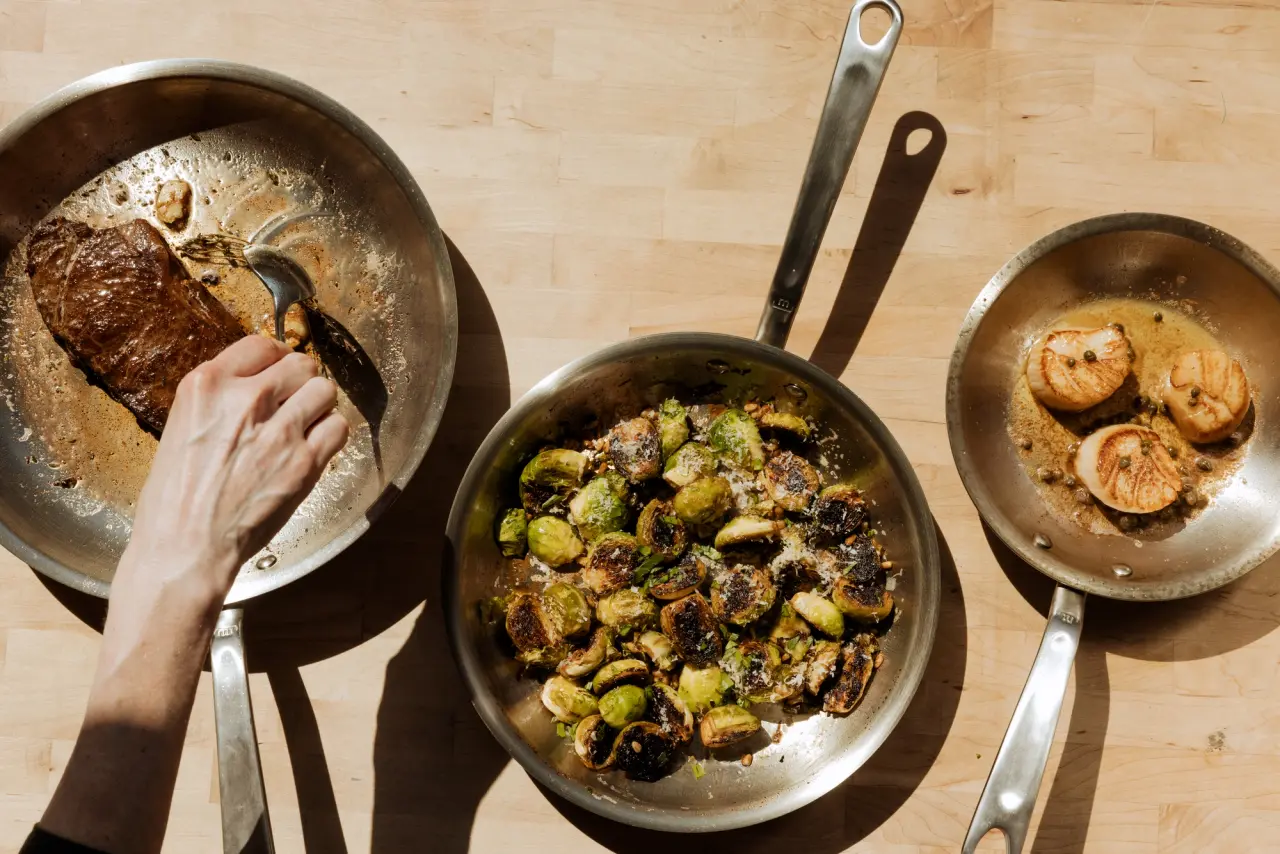It’s pizza night. What pan are you reaching for to bake or grill your ideal pie? Two options that you might run into are pizza steels and pizza stones. Both are good options for turning out pizzas with crispy crusts, but there are a few key differences between a pizza steel vs stone. Read on to learn more about pizza steels and stones, and get all the intel about our new Seasoned Carbon Steel Pizza Steel.
What Is a Pizza Steel and Pizza Stone, Anyway?
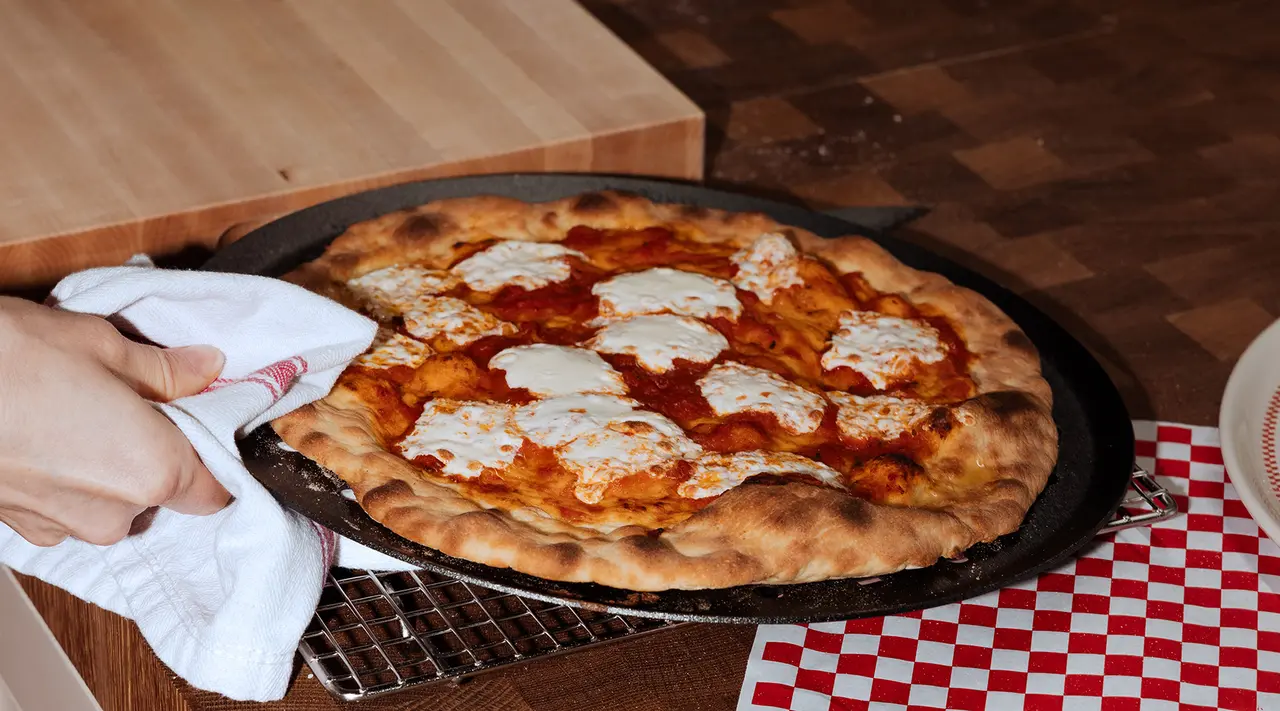
Both pizza steels and pizza stones are flat, round surfaces on which to bake or reheat a pizza. They differ in their materials, weight, and the types of foods you can use them to make.
What Is a Pizza Steel?
A pizza steel is a thin, steel plate meant for baking pizza. You’ll find them in materials like carbon steel—which is our go-to for a durable, non stick, heat conductive cooking surface.
Pizza steels often feature perforated bottoms, which help the pizza cook quickly and provide airflow to the crust, ensuring maximum crunch. You can use a pizza steel in the oven or on a grill, and you can use it to cook all manner of flatbreads, from naan to lavash to manoushe.
What Is a Pizza Stone?
Pizza stones are one large, flat piece of unglazed clay or other materials like cordierite, a type of stone used in ceramics. Similar to a pizza steel, pizza stones are typically round, making it easy to bake off a round pie in your oven.
Pizza stones absorb heat very well, making it easy to get nice crust development. Many people keep their pizza stones in the oven at all times, too, as the heat-absorbing qualities mean it can help maintain oven temperatures.
Pizza Steel vs. Stone: How Do They Compare?
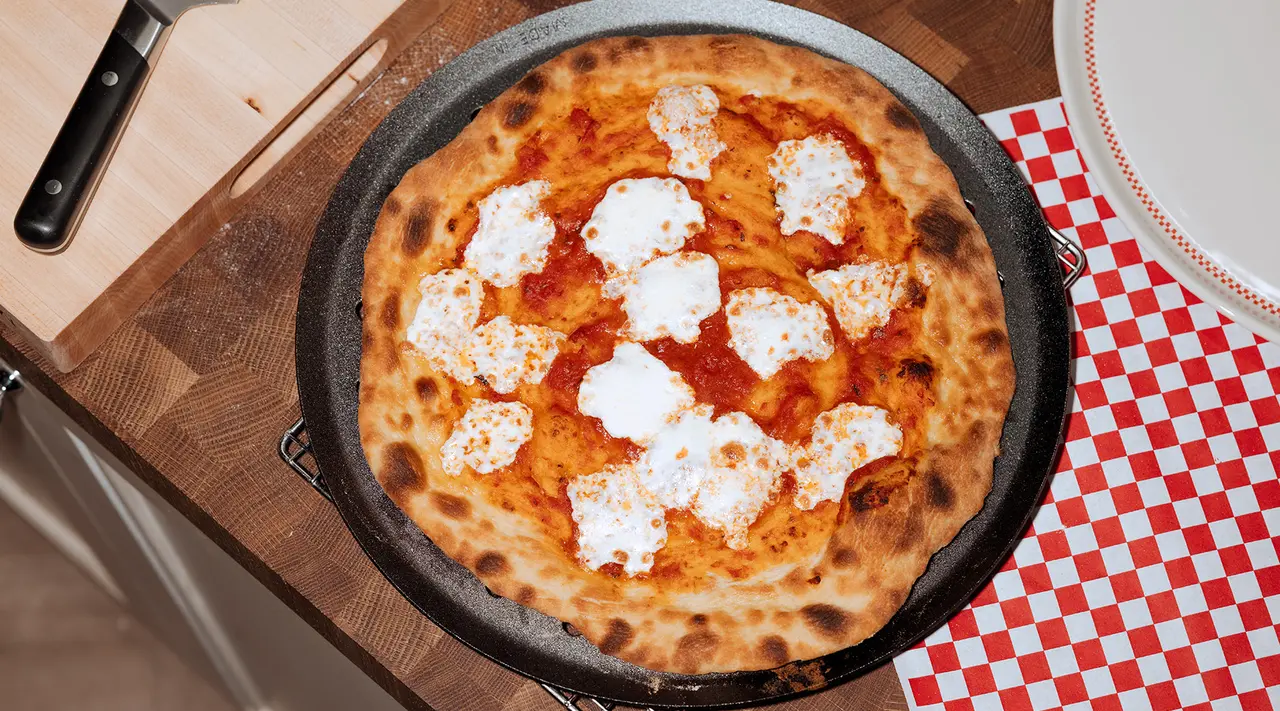
While both a pizza steel and a pizza stone are popular tools to make homemade pizza, there are a few key differences between a pizza steel vs stone.
Heat Conductivity
A pizza stone can withstand temperatures of 500F to much higher, depending on the material. (Like the rest of our Carbon Steel Collection, our Pizza Steel is safe to use up to 1200F.) When it comes to heat conductivity, steel is generally a better conductor of heat than stones.
This means a pizza steel will not only absorb heat more quickly—and thus require less time preheating in your oven—but will also release that heat onto your pizza more quickly. This means your bake time is less while still ensuring a crispy, cooked-through crust. And, since our steel features perforations which allow for better air circulation, you’ll get a really crispy, brick-oven style crust from your pie.
Durability and Maintenance
I once had a pizza stone that inexplicably cracked in the oven (probably because it was cheap; thankfully I didn’t have any food on it). While both pizza stones and pizza steels are durable, a stone is more likely to break due than a solid piece of carbon steel. Like our entire Carbon Steel Collection, the Pizza Steel is made from a single, stamped piece of carbon steel to create a thin, lightweight disc.
Care and maintenance for the pizza steel is the same as all of our Carbon Steel Cookware; with a little practice, it’ll be second nature. Pizza stones are similarly low maintenance—a simple scrape and rinse (no soap) usually suffices—though they are prone to discoloring as you use them.
Versatility in Cooking
As mentioned above, you can use a pizza stone and pizza steel to cook more than pizza. Since pizza steels are such good heat conductors, though, you’ll want to stick to quick-cooking flatbreads. With a pizza stone, however, you can also bake a loaf of bread, since the stone absorbs and maintains heat more than it pushes heat out.
Where a pizza steel really has the chance to shine is on the grill: our Pizza Steel is the ideal choice for making a flame-kissed crispy, chewy crust. Check out our extremely riffable recipe for Grilled Pizza with Mushrooms and Pepperoni, and you’ll be able to emulate pizza oven pies right at home.
Weight and Handling
When it comes to heft, a high-quality pizza stone will be heavy—potentially even up to 20 pounds (one reason to just keep it in your oven and remove it for occasional cleaning). Our Pizza Steel is lightweight, at 2.7 pounds. This makes cleaning maintenance easier, and means it's easy to transfer your steel from indoors to out.
Tips for Using a Pizza Steel
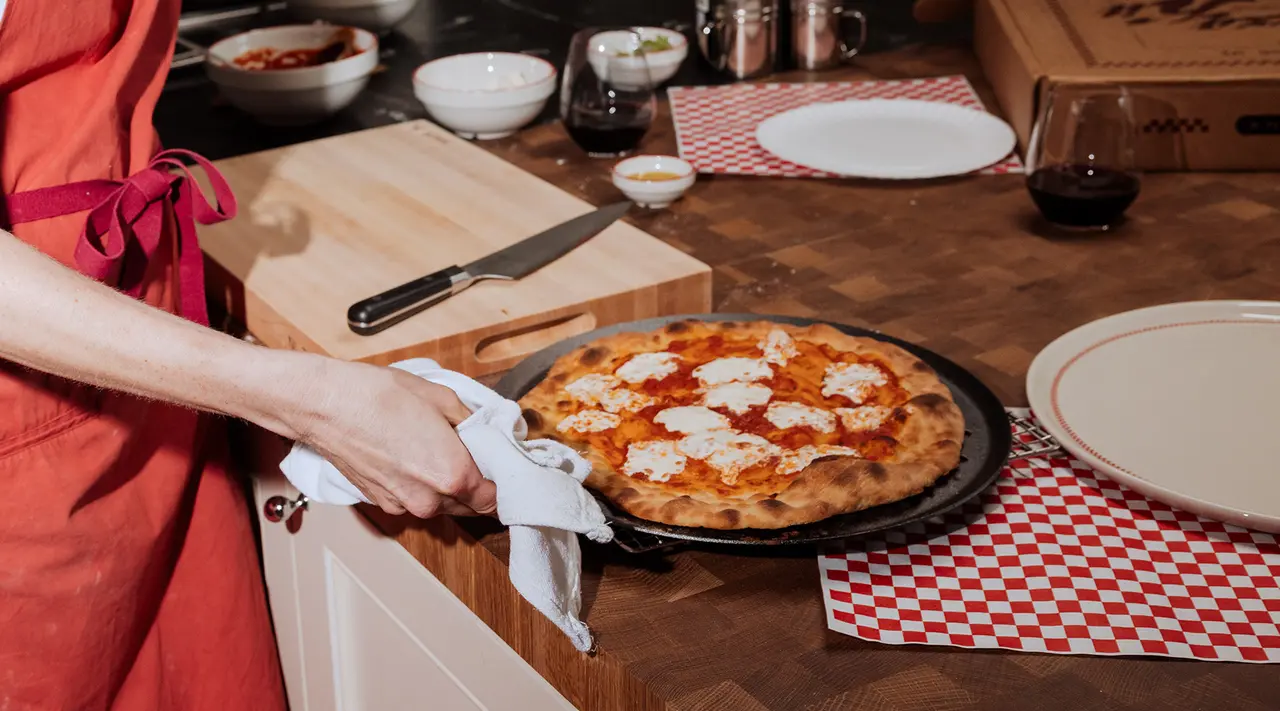
Much like the other pieces in our Carbon Steel Collection, there are a few tips and techniques that will ensure optimal success when using our new Carbon Steel Pizza Steel.
Preheating and Cooking Techniques
The 86 perforations in our pizza steel provide airflow to create an ideally burnished pie with a crispy, chewy crust. To maximize your pizza steel’s heat conductivity, preheat the steel in the oven at 500F for about 30 minutes. (If you’re making a grilled pizza, prepare a medium–high indirect heat grill, then preheat the pizza steel over direct heat for at least 10 minutes.)
Preheating means that once your dough touches the cooking surface, it’ll immediately start to cook and crisp. You will, of course, have to be careful when transferring your pizza onto the hot steel. If you don’t have a pizza peel, you can use an upside down sheet tray to slide your dough onto the steel. Either way, sprinkle a little coarse semolina flour or cornmeal onto your pizza peel to help the dough easily slide onto the steel.
Maintenance and Care
Our pizza steel comes with the first two layers of seasoning done for you, but it’s always a good idea to add an additional layer before your first use. This helps lock in those non stick properties and prevent rust.
When it’s time to clean your steel, let it cool enough so that you can handle it safely, then simply wipe your pan out with a little warm water. Dry immediately before storing. For tougher, burnt-on messes, check out our guide on caring for carbon steel. All the same rules apply.
Ready to Shop?
While both a pizza stone and a pizza steel are worthy additions to your kitchen, thanks to its versatility and ease of handling, we recommend a pizza steel. Shop our Seasoned Carbon Steel Pizza Steel and Pizza Oven Sets to ensure you never have to settle for less-than-stellar takeout pies again.








